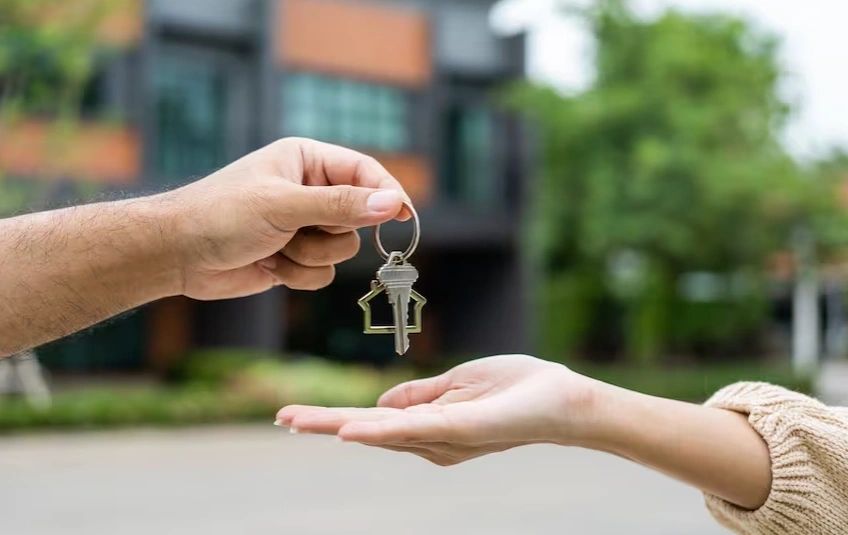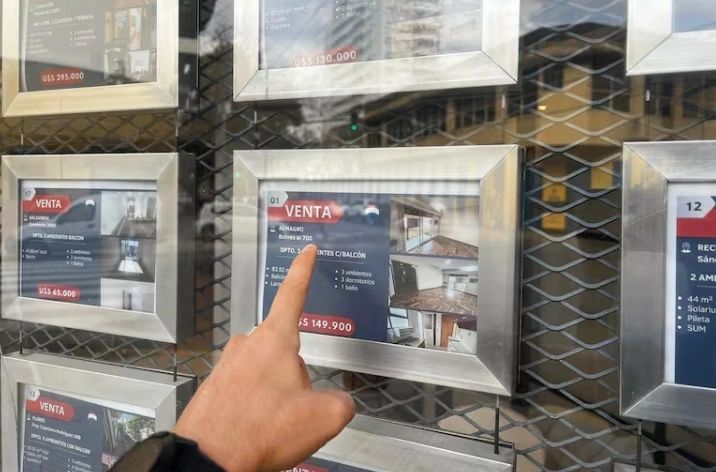BuySellBA
Administrator
Mortgage loans: The banks that didn't raise their rates and the reasons behind that decision - La Nacion Propiedades

Source:

 www.lanacion.com.ar
www.lanacion.com.ar
August 11, 2025
In November 2024, banks began raising rates on their mortgage loans, but only two are maintaining them.
By Candela Contreras

There are two banks that stand out on the Argentine mortgage credit map today because they have not raised their rates since their launch. GBJSTOCK - Shutterstock
The return of UVA mortgage loans —in April 2024—has excited not only the sector but also everyone who dreamed of owning their own home , since for almost five years this option was practically nonexistent for the middle class. However, the rise in rates that has been evident since November of last year has meant that fewer and fewer people are able to access financing .
This is because banks require that the initial loan payment represent at least 25% to 30% of the applicant's income. Therefore, the increase in interest rates directly impacts the income needed to qualify , which has not increased to the same extent. Higher interest rates, higher incomes, and more people are left out —this is the current logic.
It's important to clarify that loans take three to four months to be disbursed after the application is submitted . Therefore, the loans disbursed last month— approximately US$319 million in July —represent lines that had not yet seen a significant increase. However, what was evident is that the "credit ceiling" is already being felt , especially in the June data on deeds for the city of Buenos Aires—the most recent month surveyed—which saw a 6.46% drop compared to the previous month. This decline had already been seen in the province of Buenos Aires since May.
"It speaks of stagnation, of having reached a ceiling, although it's a marginal drop from one month to the next, and the level remains above 1,200, so it's not that significant," shared Federico González Rouco, an economist specializing in housing who works at the consulting firm Empiria.
While the average agreed-upon rate was 6.2% in July (up from 6.05% in June), the question arises: Why is it 6% when most banks are now posting a 9% or 10% interest rate?
González Rouco points out that the key lies in the composition and timing: the average agreed-upon rate reflects the rate on loans actually disbursed that month , and those loans were agreed upon—and processed— several months earlier , when conditions were more favorable. Furthermore, the statistics are weighted by volume: entities that concentrate many disbursements with low rates (such as Banco Nación and some provincial or municipal lines) drag the average down; and many private banks that raised their rates today are, in part, withdrawing from the market and reducing their share of actual disbursements. In short: what was agreed upon three or four months ago is being settled now ; the full effect of the increases will come in the coming months when the transactions originating from the sharp increases are settled.

The average agreed rate was 6.2% in JulyDaniel Basualdo
In this context, there are two banks that stand out on the Argentine mortgage lending map today because, against the tide, they have not raised their rates since their launch .
According to Banco Nación spokespersons, "a UVA spread has been defined based on the long-term vision of boosting mortgage lending for homes." They asserted that the bank "avoids altering the terms of certain credit lines based on current issues, notwithstanding the fact that the current offering has been financially sustainable in the bank's multi-year Strategic Plan." This means they are maintaining the rate to maintain volume and access according to a multi-year strategy.
In concrete numbers, since its launch in May 2024, the "+Hogares con BNA" program has granted 10,185 mortgage loans totaling $845 billion , equivalent to US$605 million. In turn, 192,600 mortgage loan applications were received and are currently being evaluated.
In the case of the NIDO loans from the Municipal Bank of Rosario, Lucas Crivelli, Secretary of Housing and Urban Development of Santa Fe, explained that the bank had deposit funds that it couldn't lend because it lacked share capital. The interest rate truce is therefore due to the entity's capitalization of $8 billion, which , according to him , freed up $60 billion for lending . Of those funds, around $15 billion have already been distributed, leaving $45 billion available.
Crivelli added operational data: 40% of loans are granted in Rosario , the maximum age for access is around 65 (in some cases up to 75), the program started with very rapid distribution but is currently stuck at 40,000 registrants, with 400 people per month, and of those, 25% actually obtain the loan. Approval times are between 90 and 120 days , with a minimum of 30 days to build the loan portfolio.
That Banco Nación and the Municipal Bank of Rosario have not raised their rates now is news - and a relief for those who are applying - but it does not solve the macroeconomic equation : without growing income, without stable funding and without more agile processes, owning a home will continue to be a privilege for fewer and fewer people .
Other banks that did not show any changes in their rates as published on their websites are: Banco de Neuquén (maintaining its APR at 3.5% and 4.5%) and Banco de Corrientes (continuing at 5%) .

There are banks that have not yet shown any rate increases on their mortgage loans.Freepik
This gap creates a liquidity problem : every time loans are granted, banks need to fund themselves at a higher rate to maintain their stock. The system's natural response is to raise the Annual Nominal Rate (ANR) to moderate access. "There is a huge demand that has grown very quickly, and at the same time, funding mortgage loans is expensive for banks because these loans have very high ticket prices," the economist notes.
This makes loans more expensive and reduces the number of people who can afford to own their own homes.
Therefore, the outlook suggests that this market is going through a period of maturity that requires new tools to recover : long-term funding sources, more competitive rates, public policies that incentivize securitization, and a stable macroeconomic agenda.
In May 2024 , Federico González Rouco spoke of a " good time ": cheap real estate and reasonable rates for those planning to become homeowners. Today, faced with rising rates and the growing gap between income and income, the question is: is it still a good time?
www.buysellba.com
Source:

Créditos hipotecarios: los bancos que no subieron sus tasas y las razones detrás de esa decisión
En noviembre de 2024, las entidades bancarias comenzaron a subir las tasas de sus líneas de préstamos hipotecarios pero solo dos las mantienen
August 11, 2025
In November 2024, banks began raising rates on their mortgage loans, but only two are maintaining them.
By Candela Contreras

There are two banks that stand out on the Argentine mortgage credit map today because they have not raised their rates since their launch. GBJSTOCK - Shutterstock
The return of UVA mortgage loans —in April 2024—has excited not only the sector but also everyone who dreamed of owning their own home , since for almost five years this option was practically nonexistent for the middle class. However, the rise in rates that has been evident since November of last year has meant that fewer and fewer people are able to access financing .
This is because banks require that the initial loan payment represent at least 25% to 30% of the applicant's income. Therefore, the increase in interest rates directly impacts the income needed to qualify , which has not increased to the same extent. Higher interest rates, higher incomes, and more people are left out —this is the current logic.
It's important to clarify that loans take three to four months to be disbursed after the application is submitted . Therefore, the loans disbursed last month— approximately US$319 million in July —represent lines that had not yet seen a significant increase. However, what was evident is that the "credit ceiling" is already being felt , especially in the June data on deeds for the city of Buenos Aires—the most recent month surveyed—which saw a 6.46% drop compared to the previous month. This decline had already been seen in the province of Buenos Aires since May.
"It speaks of stagnation, of having reached a ceiling, although it's a marginal drop from one month to the next, and the level remains above 1,200, so it's not that significant," shared Federico González Rouco, an economist specializing in housing who works at the consulting firm Empiria.
While the average agreed-upon rate was 6.2% in July (up from 6.05% in June), the question arises: Why is it 6% when most banks are now posting a 9% or 10% interest rate?
González Rouco points out that the key lies in the composition and timing: the average agreed-upon rate reflects the rate on loans actually disbursed that month , and those loans were agreed upon—and processed— several months earlier , when conditions were more favorable. Furthermore, the statistics are weighted by volume: entities that concentrate many disbursements with low rates (such as Banco Nación and some provincial or municipal lines) drag the average down; and many private banks that raised their rates today are, in part, withdrawing from the market and reducing their share of actual disbursements. In short: what was agreed upon three or four months ago is being settled now ; the full effect of the increases will come in the coming months when the transactions originating from the sharp increases are settled.

The average agreed rate was 6.2% in JulyDaniel Basualdo
In this context, there are two banks that stand out on the Argentine mortgage lending map today because, against the tide, they have not raised their rates since their launch .
Two different cases: those that did not raise the rate
Banco Nación maintains the APR at 4.5% ; and Banco Municipal de Rosario has the lowest rate on the market, at 3% for its payroll account customers and 4.2% for those who do not receive their paychecks at the bank.According to Banco Nación spokespersons, "a UVA spread has been defined based on the long-term vision of boosting mortgage lending for homes." They asserted that the bank "avoids altering the terms of certain credit lines based on current issues, notwithstanding the fact that the current offering has been financially sustainable in the bank's multi-year Strategic Plan." This means they are maintaining the rate to maintain volume and access according to a multi-year strategy.
In concrete numbers, since its launch in May 2024, the "+Hogares con BNA" program has granted 10,185 mortgage loans totaling $845 billion , equivalent to US$605 million. In turn, 192,600 mortgage loan applications were received and are currently being evaluated.
In the case of the NIDO loans from the Municipal Bank of Rosario, Lucas Crivelli, Secretary of Housing and Urban Development of Santa Fe, explained that the bank had deposit funds that it couldn't lend because it lacked share capital. The interest rate truce is therefore due to the entity's capitalization of $8 billion, which , according to him , freed up $60 billion for lending . Of those funds, around $15 billion have already been distributed, leaving $45 billion available.
Crivelli added operational data: 40% of loans are granted in Rosario , the maximum age for access is around 65 (in some cases up to 75), the program started with very rapid distribution but is currently stuck at 40,000 registrants, with 400 people per month, and of those, 25% actually obtain the loan. Approval times are between 90 and 120 days , with a minimum of 30 days to build the loan portfolio.
That Banco Nación and the Municipal Bank of Rosario have not raised their rates now is news - and a relief for those who are applying - but it does not solve the macroeconomic equation : without growing income, without stable funding and without more agile processes, owning a home will continue to be a privilege for fewer and fewer people .
Other banks that did not show any changes in their rates as published on their websites are: Banco de Neuquén (maintaining its APR at 3.5% and 4.5%) and Banco de Corrientes (continuing at 5%) .

There are banks that have not yet shown any rate increases on their mortgage loans.Freepik
The current market situation
To understand the rate hike, it's important to understand the current market situation: demand outstrips supply of funds. Banks finance their portfolios with short-term deposits (generally less than 90 days), while UVA loans extend to 20 or even 30 years . This difference creates tension: "You can't finance for 30 years if your deposits are for 30 days," several specialists analyze.This gap creates a liquidity problem : every time loans are granted, banks need to fund themselves at a higher rate to maintain their stock. The system's natural response is to raise the Annual Nominal Rate (ANR) to moderate access. "There is a huge demand that has grown very quickly, and at the same time, funding mortgage loans is expensive for banks because these loans have very high ticket prices," the economist notes.
This makes loans more expensive and reduces the number of people who can afford to own their own homes.
Therefore, the outlook suggests that this market is going through a period of maturity that requires new tools to recover : long-term funding sources, more competitive rates, public policies that incentivize securitization, and a stable macroeconomic agenda.
In May 2024 , Federico González Rouco spoke of a " good time ": cheap real estate and reasonable rates for those planning to become homeowners. Today, faced with rising rates and the growing gap between income and income, the question is: is it still a good time?
www.buysellba.com

